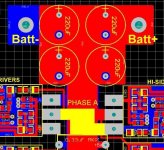HighHopes said:I was thinking more on the sinusoidal case, and now I find possible that HighHopes's formula is the correct one for the fully symmetrical sinusoidal drive, and mine is not applicable in this case
lol no worries. we're just discussing theory.
That's correct!
But I didn't say I agree with your calculation, just that it needs more investigation for me to understand the 3P sinusoidal case. I started thinking on this because Zombiess told me I would need only 20..30uF based on your formula, that I strongly doubted, and I don't want the people here to be misguided with a wrong calculation... In my case I need at least a 10 times bigger capacitor if it is a film cap.
Of course I'm sure your circuit works, but I'm pretty sure that in the worst case situations your ripple current is a lot larger than your estimation. Unfortunately measuring the ripple current waveform is not easy when the capacitors are soldered on the board.
As you see I also simplified a lot in my model, but in my opinion you ignored the most important part of the capacitor current, that is the DC component of the phase current, that I did not ignore. Your calculation is based on only the phase ripple current, because you said your worst case simulation started at bemf=0, i=0 and maximum torque applied. But as I see, it will not give the worst case capacitor ripple current, because when the phase current is at maximum, 100..200A or more, it cannot be ignored, this is much more than the phase ripple current.
And now I see it is the case for the sinusoidal drive, too: just imagine when you switch any of the phases from low to high or high to low voltage, then the phase current of that phase is added to or subtracted from the bridge supply current via the high side FET of that phase. This change in the current is the ripple in the DC bus current, and its level is the actual phase current along the sine wave. If the peak phase is 200A, then it is between -200 and +200A. During one PWM period there is a low to high and a high to low change on every phase, that gives a current curve from 0A to the maximum, and this curve dynamically changes along the sine wave. The AC component of this curve is the capacitor peak-to-peak ripple current, and its RMS is what we are interested in. Finding the maximum ripple would be an optimization task (function of the voltage sine wave amplitude, the phase degree and maybe other variables), but my calculation for 1 phase DC gives an upper approximation of the worst case, this is how I see it.



